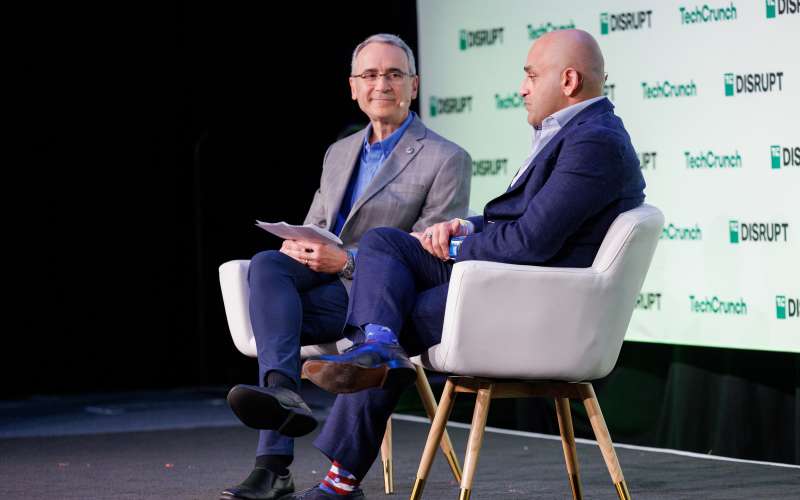New opportunities for commercial collaboration are driving rapid innovation, opening up new pathways and options for the nation’s space programs to approach mission designs and systems.
Recently held in San Francisco, TechCrunch Disrupt 2024 highlighted the latest breakthroughs in technology, and the value of collaboration between the public and private sectors. The yearly event is open to entrepreneurs, investors, tech enthusiasts and media from around the world.
The Aerospace Corporation once again joined forces with TechCrunch to deliver engaging panel discussions with leaders across defense, civil and commercial space, as well as a Space Challenge pitch-off for startups to showcase innovative concepts poised to transform commercial space operations.
During the event, Aerospace demonstrated its commitment to advancing space technology and fostering collaboration across government partners with the tech community to accelerate innovation. The company also emphasized the vital role that startups play by providing fresh perspectives, challenging traditional approaches and enhancing the agility and resilience of space operations.
Cislunar: The Next Frontier
With NASA's Artemis program aiming to return humans to the Moon by 2025 and establish a sustainable presence, cislunar space is poised to become a critical zone for future space operations. The Cislunar: The Next Frontier session delved into the exciting prospects of lunar exploration and the strategic significance of the cislunar space — the area between the Earth and the Moon.
During this session, Aerospace President and CEO Steve Isakowitz joined NASA Chief Technologist AC Charania for a fireside chat that explored cislunar space as a key area for future commercial activity, infrastructure and technology development, and as a platform for deeper space exploration.

“The strategy at NASA is not only to return to the Moon but to have longer surface stays, maturing technologies, developing a lunar space station and getting the experience to then help us achieve a human exploration mission to Mars and to the rest of the solar system,” said Charania.
Their conversation emphasized the critical role of public-private partnerships, the opportunities and challenges of building a thriving lunar ecosystem, and how the commercial sector is positioning itself at the heart of this new era of exploration.
“It used to be true rocket science to get satellites into space,” said Isakowitz. “But it’s no longer the world’s super-powers that are doing this. It’s startups, and with a few million dollars, they can put great things in space.”
Startups in Dual Use
Another prominent topic was that of “dual use” technologies or systems designed to serve both civilian and military purposes, allowing for versatile applications in areas such as satellite communications, navigation, imaging and space exploration.
Aerospace VP and CTO Dr. Debra Emmons participated in a panel focused on startups in dual use, where she joined industry leaders in discussing the challenges and opportunities for startups entering the highly regulated government and defense sectors in an environment dominated by traditional prime contractors. The panel also addressed the ways investors can help startups compete for government and defense contracts.
“If you’re a startup, you really have to be thinking about what a sustainable business is. Having advisors in the areas of policy and the regulatory can really help you build relationships and trust,” said Emmons. “Going forward, we’re going to need to see more flexible funding and a change in the culture of risk aversion, and the way you build that change in the culture is through successes.”
Future of Space Operations Challenge

Given the evolving landscape of space missions and the complexities involved in managing operations beyond Earth, the Future of Space Operations was a prominent theme at this year's conference. As commercial space activities continue to expand, the need for robust operational frameworks and innovative solutions has become increasingly critical.
Aerospace was once again proud to sponsor and organize its yearly pitch-off, creating an open call for a competition for space startups working in five areas: robotics, autonomous systems, AI/ML, vision systems, and propulsion and navigation. Engineering and science teams at Aerospace reviewed and selected the most compelling innovations from these companies. Teams from each of the five finalist companies were given the opportunity to present four-minute pitches followed by questions from the judges.
Isakowitz congratulated this year’s winner -- Xona Space Systems’ PULSAR, the first direct-to-device precision satellite navigation service. For its winning pitch, Xona Space Systems was awarded access to expert-led feedback sessions with Aerospace and government experts, and commercial space leadership.
Fostering Collaboration with Startups and Tech Innovators
Aerospace’s contributions to this year’s TechCrunch Disrupt serve as a reminder of the potential for space technology to transform not only how humanity explores the universe, but also how to operate within it. By engaging with industry leaders, innovators, and policymakers, Aerospace continues to showcase its expertise and vision for a collaborative, safe, and prosperous future in space.
As the space industry continues to evolve rapidly, Aerospace remains at the forefront, driving innovation and underscoring its mission to inspire, equip and nurture the next generation of space innovators.






